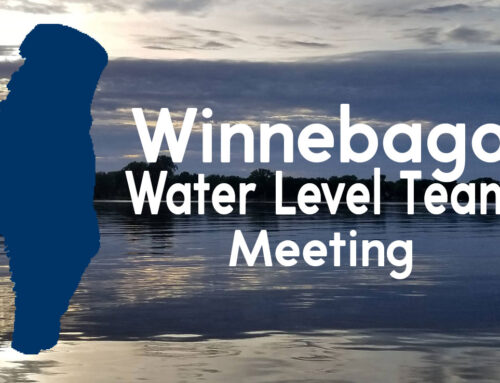Although it’s winter and the lakes are frozen over, the thick green, smelly algae blooms are still a recent memory for many of us who like to spend time boating or swimming in the Winnebago System. The combination of high temperatures and phosphorus resulted in the Winnebago Lakes looking like what many described as ‘pea soup’. On the north end of Lake Winnebago, the algae formed a blue mat on the surface so thick it looked like you might be able to walk across it. Not only does algae smell horrific, blue-green algae has the potential to release toxins that are harmful to humans and animals (including pets!).
While algae are a healthy part of a natural lake system in small amounts, the severe blooms we see in the Winnebago Lakes are evidence that our lakes are out of balance. The lakes have too much phosphorus and not enough aquatic plants to use it. There are two main sources of phosphorus in the Winnebago Lakes:
(1) Agriculture and urban nutrient runoff from the watershed
(2) Phosphorus that has built up in the lake sediments after decades of nutrient pollution
The Winnebago Waterways Lake Management Planning team is developing recommendations to get our lakes back into balance by:
(1) reducing agriculture and urban nutrient runoff
(2) restoring aquatic plants.
Over the past several decades, the lakes have seen a major loss of aquatic plants because of high water levels and erosion. Aquatic plants take-up phosphorus and anchor the sediment. A water level strategy that will allow aquatic plants to grow would help reduce the amount of phosphorus available to algae. This strategy implemented consistently over multiple years along with a reduction of nutrient runoff from the landscape would reduce the frequency and severity of algae blooms.
Water levels in Lake Winnebago are artificially controlled by two dams: one in Neenah (privately owned) and one in Menasha. The dam in Menasha is operated by the Army Corps of Engineers. As part of the Lake Management Planning process, a group of representatives from the system formed the Water Level Tech Team. That team met to discuss and develop a slightly modified water level strategy for Lake Winnebago to try to increase the amount of plants. The proposed strategy was presented to the Army Corps of Engineers toward the end of 2018.
Recommendations include:
- Shift summer water level target range down 1.2 inches.
- Hold water levels toward the lower end of the target range, when possible.
- Extend summer water level target through October for fall boating.
- Shrink winter drawdown target range.
- Form an ongoing committee made up of diverse stakeholders to review lake conditions and provide input to the Army Corps prior to the spring refill, fall regulation, and winter drawdown meetings.
Read more about the recommendations HERE
The Army Corps is hold a public meeting to allow members of the public to discuss and provide input on that proposed modified strategy on Thursday, January 17th, 2019. You can view their full public meeting notice HERE.
Around 70 people attended the meeting. During that meeting, Korin Doering from Fox-Wolf Watershed Alliance, presented on the proposed changes and answered numerous questions about the goals and possible outcomes of the strategy. There were also representatives from the DNR on hand to answer questions about the fisheries, aquatic plant management permitting, among other topics. The questions and comments led to great discussions about a variety of issues related to water levels. At the end of the meeting, the Army Corps asked for a show of hands to see how many people were in support of or opposed to the changes. The majority of people in the room were in support of the proposed changes.
The next steps:
1.) Army Corps of Engineers will bring the proposed changes to their superiors for review and a final decision for 2019.
2.) The Army Corps will hold another public meeting near the end of February to discuss the 2019 strategy and finalize the decision for the 2019 winter drawdown target (based on basin conditions).
3.) Fox-Wolf Watershed Alliance will begin forming the Winnebago Water Level Assessment Team. The group will be made up of stakeholder representatives from around the system who will meet a few times a year to discuss the water level targets and assess whether additional recommendations need to be made based on basin conditions, lake conditions, and stakeholder needs. The goal is to have an organized, constructive stakeholder voice to support the Army Corps with adaptive management of water levels in Lake Winnebago.
Recreation is an important part of our lakes, our regional identity, and local economy. We understand that aquatic plants can be a nuisance to recreation in certain areas so we are working to develop strategies to deal with plants in the lakes in places where they might impede navigation or other activities (such as swimming).
Ultimately, our goal is improved water quality and a healthier lake system.
Questions? Comments? Contact Korin Doering at (920) 851-0948 or korin@fwwa.org
Winnebago Waterways is a Fox-Wolf Watershed Alliance program. The Fox-Wolf Watershed Alliance is an independent nonprofit organization that identifies and advocates effective policies and actions that protect, restore, and sustain water resources in the Fox-Wolf River Basin.







